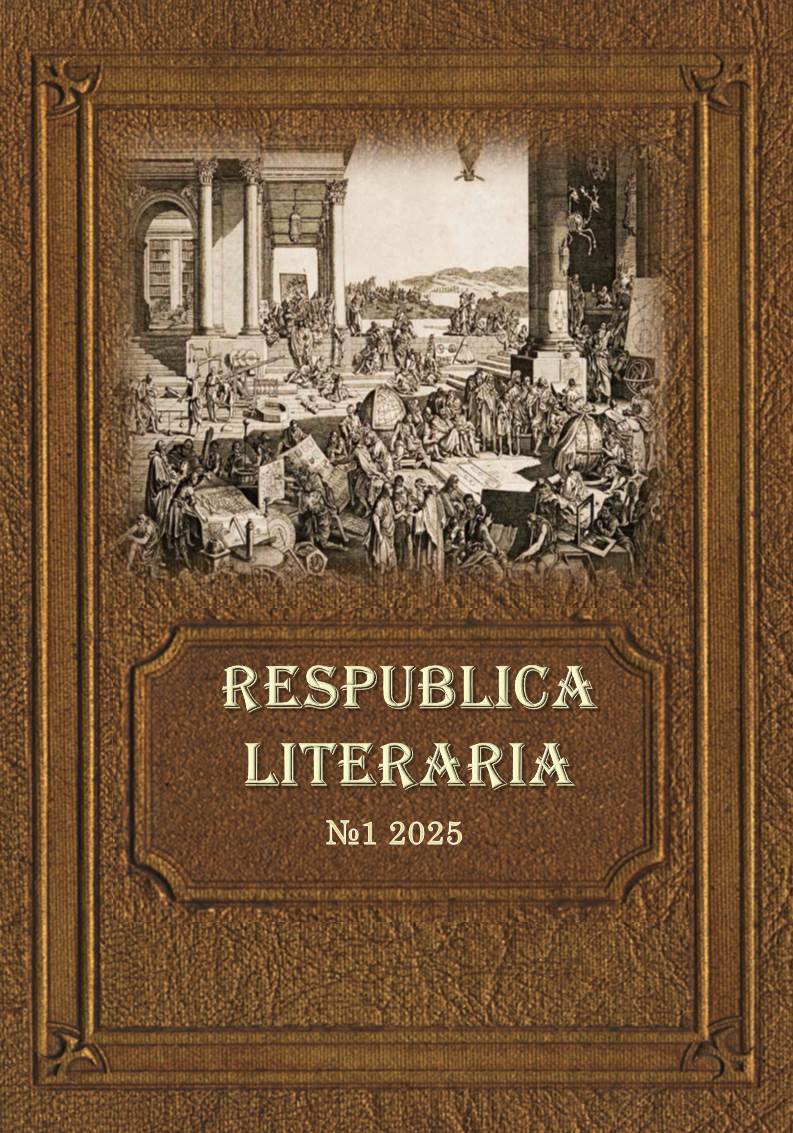Space-Time Semiotics in Information Technology Applications
DOI:
https://doi.org/10.47850/RL.2025.6.1.16-26Keywords:
semiosis, semiotics, information technology, IT, geographic information systems, GIS, engineering, artificial intelligenceAbstract
The paper studies the problem of human perception of space and time in the context of the widespread introduction of information and communication technologies. From the viewpoint of philosophy, the interaction of the subject with the surrounding world in dynamics forms an integrated “space and time” environment, which contains several variations or versions reflecting the objective and virtual reality of possible development scenarios. These issues are considered within the framework of scientific directions of geoinformatics, cartographic semiotics, and geo-semiotics, on the basis of which it is possible to build a new model of visualization and perception of space and time based on cartographic representation. This leads to a change in language being used to present the information and in general vocabulary and signs processed by a person in the process of perception. In this context there is considered a semiotics of space-time in modern applications of information technology.
References
Базина, М. А., Побединский, Г. Г. (2008). Проблема оптимальной визуализации геопространственных данных в процессе управления территориями и объектами. Системы и средства информатики. Т. 18. № 3. С. 204-223.
Bazina, M. A., Pobedinsky, G. G. (2008). The problem of optimal visualization of geospatial data in the process of managing territories and objects. Systems and Means of Informatics. Vol. 18. No. 3. Pp. 204-223. (In Russ.)
Бахтин, М. М. (1986). Формы времени и хронотопа в романе. Очерки по исторической поэтике. Литературно-критические статьи. М.: Худ. лит. С. 121-290.
Bakhtin, M. M. (1986). Forms of Time and Chronotope in the Novel. Essays on Historical Poetics. In Literary-Critical Articles. Moscow. Pp. 121-290. (In Russ.)
Берлянт, А. М. (2008). Большая картография или интеграция картографии, геоинформатики и дистанционного зондирования: учебное пособие. М.: ГУЗ. 118 с.
Berlyant, A. M. (2008). Large-Scale Cartography or Integration of Cartography, Geoinformatics and Remote Sensing. Training Manual. Moscow. 118 p. (In Russ.)
Бескид, П. П., Куракина, Н. И., Орлова, Н. В. (2013). Геоинформационные системы и технологии. СПб.: Рос. гос. гидромет. ун-т. 173 с.
Beskid, P. P., Kurakina, N. I., Orlova, N. V. (2013). Geoinformation Systems and Technologies. St. Petersburg. 173 p. (In Russ.)
Большой психологический словарь. (2009). Под ред. Б. Г. Мещерякова, В. П. Зинченко. Изд. 4-е, расш. М.: АСТ. 811 с.
Meshcheryakov, B. G., Zinchenko, V. P. (eds.). (2009). The Large Psychological Dictionary. 4th ed., expanded. Moscow. 811 p. (In Russ.)
Иванников, А. Д., Кулагин, В. П., Тихонов, А. Н., Цветков, В. Я. (2001). Геоинформатика. М.: МАКС Пресс. 349 с.
Ivannikov, A. D., Kulagin, V. P., Tikhonov, A. N., Tsvetkov, V. Ya. (2001). Geoinformatics. Moscow. 349 p. (In Russ.)
Массер, Д. (2018). Что есть пространство-время? В мире науки. № 8-9. С. 78-82.
Masser, D. (2018). What is Space-Time? In the World of Science. No. 8-9. Pp. 78-82. (In Russ.)
Пирс, Ч. С. (2009). Что такое знак? Вестник Томского государственного университета. Философия. Социология. Политология. № 3 (7). С. 88-95
Pierce, C. S. (2009). What is a Sign? Bulletin of Tomsk State University. Philosophy. Sociology. Political Science. No. 3 (7). Pp. 88-95. (In Russ.)
Повалко, П. Ю. (2016а). Пространство и время как категории художественного текста. Вестник Российского университета дружбы народов. Серия: теория языка. Семиотика. Семантика. № 3. С. 106-112.
Povalko, P. Yu. (2016a). Space and Time as Categories of Fiction Text. Bulletin of RUDN University. Series: Theory of Language. Semiotics. Semantics. No. 3. Pp. 106-112. (In Russ.)
Повалко, П. Ю. (2016б). Функции категорий пространства и времени в художественном тексте. European Journal of Literature and Linguistics. №. 3. С. 51-54.
Povalko, P. Yu. (2016b). Functions of the categories of space and time in a fiction text. European Journal of Literature and Linguistics. No. 3. pp. 51-54. (In Russ.)
Ухтомский, А. А. (2022). Доминанта. М.: АСТ. 320 c.
Ukhtomsky, A. A. (2022). The Dominant. Moscow. 320 p. (In Russ.)
Флоренский, П. А. (1993). Анализ пространственности и времени в художественно-изобразительных произведениях. М.: Прогресс. 324 с.
Florensky, P. A. (1993). Analysis of Spatiality and Time in Artistic and Visual Works. Moscow. 324 p. (In Russ.)
Casti, E. (2005). Towards a Theory of Interpretation: Cartographic Semiosis. Cartographica: The International Journal for Geographic Information and Geovisualization. Vol. 40. No. 3. Pp. 1-16.
Dai, J., An, L. (2018). Time Geography. Comprehensive Geographic Information Systems. Vol. 3. Pp. 303-312. DOI: 10.1016/B978-0-12-409548-9.09625-1
Dodge, S., Su, R., Johnson, J., Simcharoen, A., Goulias, K., Smith, J. L. D., Ahearn, S. C. (2021). ORTEGA: An Object-Oriented Time-Geographic Analytical Approach to Trace Space-Time Contact Patterns in Movement Data. Computers, Environment and Urban Systems. Vol. 88. Article 101630. DOI: https://doi.org/10.1016/j.compenvurbsys.2021.101630
Eremchenko, E. N. (2022). Semiotics from maps to digital earth: conundrums and challenges. In Proceedings of II International Scientific Conference Landscape Dimension of Sustainable Development: Science, CartoGis, Planning, Governance. Tbilisi. Tbilisi State University. Pp. 17-25.
Friedman, A., Smiraglia, R. (2013). Nodes and Arcs: Concept Map, Semiotics, and Knowledge Organization. Journal of Documentation. Vol. 69. Iss. 1. Pp. 27-48. DOI: 10.1108/00220411311295315
Gašperič, P., Babič, S. (2023). The Semiotics of Cartographic Symbols on Old Maps. Acta Geographica Slovenica. Vol. 63. DOI: 10.3986/AGS.10930
Gospodinov, S. G. (2022). Geoinformatics as a Science of Space. European Journal of Technology and Design. Vol. 10-1. Pp. 3-8.
Rynasiewicz, R. (2022). Newton’s Views on Space, Time, and Motion. [Online]. The Stanford Encyclopedia of Philosophy (Spring Edition). Zalta, E. N. (ed.). Available at: https://plato.stanford.edu/entries/newton-stm/ (Accessed: 30 January 2025).
Schlichtmann, H. (2009). Overview of the semiotics of maps. [Online]. In Proceedings of the 24th International Cartographic Conference. Santiago de Chile, Chile, 15–21 November 2009. Pp. 1 12. Available at https://icaci.org/files/documents/ICC_proceedings/ICC2009/html/ refer/30_1.pdf (Accessed: 30 January 2025).
Yuan, M. (2020). Relationships between Space and Time. Geographic Information Science & Technology Body of Knowledge. DOI: 10.22224/gistbok/2020.3.7
Zyszkowska, W. (2000). Semiotic Aspects of Cartographic Visualization. In Acta Universitatis Wratislaviensis, Studia Geograficzne. Pp. 130-132.
Downloads
Published
How to Cite
Issue
Section
License

This work is licensed under a Creative Commons Attribution-NonCommercial-NoDerivatives 4.0 International License.
https://oc.philosophy.nsc.ru/remote.php/webdav/%D0%94%D0%BE%D0%B3%D0%BE%D0%B2%D0%BE%D1%80%20%D1%81%20%D0%B0%D0%B2%D1%82%D0%BE%D1%80%D0%BE%D0%BC%20RL-%D0%BF%D1%80%D0%B0%D0%B2.doc





